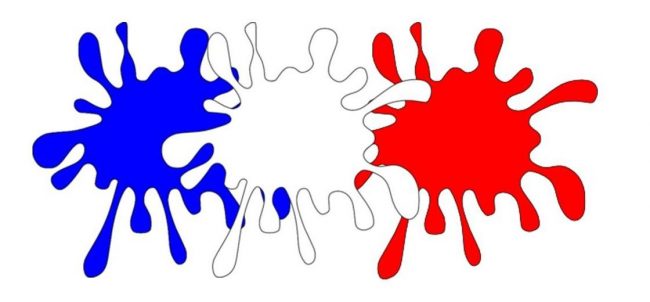Irish Phrases and Idioms Using ‘Red,’ ‘White,’ and ‘Blue’ (Dearg, Bán, Gorm), pt. 2 Posted by róislín on Jun 26, 2016 in Irish Language
(le Róislín)
Most recently, we looked at the Irish for “red” (dearg) inspired by the timely red, white and blue color schemes one sees a lot around this time of year, sna Stáit Aontaithe, ar a laghad.

Hmm, an bhfuil difear ar bith idir “splat” agus “splotch” i mBéarla? Thabharfainn “smearthaí” orthu seo i nGaeilge. (na grafaicí: http://www.clker.com/clipart-49390.html; http://www.clker.com/clipart-white-10.html; http://www.clker.com/clipart-blue-4.html)
So that was “dearg,” and we had lots of examples: Clóicín Dearg, léine dhearg, cuiríní dearga, báid dhearga, and bádaí dearga, as well as, of course, the combination “dearg, bán, agus gorm,” for the American and French flags, among others.
Today we’ll look at the color “white,” some of its basic forms and some specialized or idiomatic meanings.
Na bunrudaí, ar dtús: bán [bwawn], bhán [wawn OR vawn], bána [BwAWN-uh], bhána [WAWN-uh OR VAWN-uh]
a) bán, white, can also mean: fair (complexion, hair), white-headed, pale, blank, empty, fallow, etc.
capall bán, a white horse
páipéar bán, a white paper
áit bhán, an empty place (but note: bosca folamh, an empty box)
talamh bán, fallow land
torann bán, white noise
NB: for “white” as in Caucasian skin tone, the word “geal” is generally used (duine geal, cine geal), and “geal” is also used in describing White Slave Trafficking (Gáinneáil ar Sclábhaithe Geala). However, we also do have the word “bánach” (a white person, also, outside of the racial context, “a fair-haired person”). “Albino,” though, is “ailbíneach.”
Samplaí:
Cén dath a bhí ar chapall bán George Washington? Á, tá brón orm–tá a fhios agam gur “seanchastán” atá ann, ach ní “old chestnut” mar “chapall rua” nó mar “chapall buí” atá i gceist, ach “old chestnut” mar “seanscéal agus meirg air.”
Róisín Bán agus Róisín Dearg (leagan Mháiréad Ní Ghráda den fabhalscéal). Curious how “Snow” is no longer in the title, and we actually have a tale of “beirt Róisíní” completely different from that told by Séamus Ó Grianna in his Mo Dhá Róisín.
b) bhán, with an inserted “h,” changing the initial sound to a “w” or a “v”: in phrases like:
dair bhán, white oak
léine bhán, a white shirt
péisteog bhán, a grub or a pot worm, lit. a small white worm
putóg bhán, white pudding (a type of sausage)
Or , a little more abstractly:
páirc bhán, a lea or bawn, lit. an empty/white field
léarscáil bhán, an empty map
téip bhán (in recording): blank tape (aka téip ghlan, lit. “clean” tape)
téip bhán (in sports), white tape
Sampla: “A Úna Bhán, ba rós i ngairdín thú, / Ba choinnleoir óir ar bhord na banríona thú …” (“Fair Úna, you were a rose in a garden / You were a candlestick of gold on the table of the queen …” from the song “Úna Bhán”)
What do all of those all have in common? They’re all feminine and singular. The patterns will change for the plural, as in the next section (c):
c) bána, white (the plural form), used the majority of the time when the noun is plural–I’d estimate about 95%, but that is just a rough guess. Examples include:
boscaí bána, white boxes
léinte bána, white shirts
bróga bána, white shoes
na Buachaillí Bána, the Whiteboys
bráithre bána, bee grubs or bee larvae; presumably one such grub would be a “bráthair bán,” but the phrase seems to more widely used in the plural. “Larbha” can also be used for larva, in general.
And, curiously, for anyone who actually owns a Brocaire Bán na nGarbhchríoch, or some other white dog (Measán Máltach, Spitse Seapánach, nó Measán Catach .i. Bichon Frise, to name just a few), we have:
madraí bána, beetle grubs, and again, presumably a “madra bán” could be one beetle grub. Sort of sheds new light on the phrase “tá dóigh an mhadra bháin orm,” doesn’t it? “Madraí bána” literally means “white dogs.”
d) And finally, there’s “bhána” used for nouns (like páipéar or bád) made plural by removing the second “a” and inserting an “i” just before the end.
báid bhána (but remember the alternate plural, bádaí, in the phrase “bádaí bána,” which would take us back to the previous form, just plain “bána,” with no “h,” i.e. no lenition.
Samplaí: Páipéir Bhána is Páipéir Bhreaca, a book by Máirtín Ó Cadhain (also author of the Gaeltacht classic, Cré na Cille)
So that’s a sampler anyway, avoiding the forms used with possessive nouns, since that would take up least another full blog (the lid of the white box, etc.)
BTW, the widely-used Irish word “ban” is a near “comhainm” for “bán” but remember that although the two words look and sound similar, they are completely different in meaning, and reasonably different in pronunciation. The similarity is no more that what we might find with the pair “lón” (lunch) and “lon” (ouzel). “Ban,” as you may remember, means “of women,” and shows up in phrases like hataí ban or, with an initial “m,” Sliabh na mBan (Slievenamon).
The “tuiseal ginideach” forms will have to wait for another blogpost.
Anyway, that’s one more color down in our trio of “dearg, bán, agus gorm” as found in the American “Na Réaltaí agus na Riabha” and in France’s Trídhathach. “Bán,” done, “gorm,” le teacht.
SGF — Róislín
P.S. And, let’s see, hmm, how many other nations’ flag have an dath bán in them. Cuid mhór, sílim. Bratach do thíre féin?

Build vocabulary, practice pronunciation, and more with Transparent Language Online. Available anytime, anywhere, on any device.




Leave a comment: